Santiago
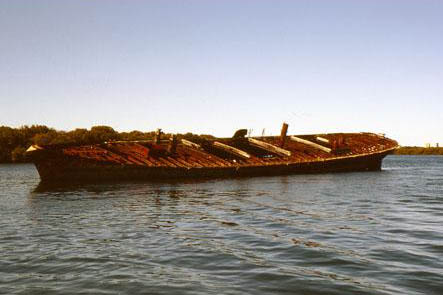
(© Dept.for Environment and Heritage, South Australia)
by Mary A. Reilly
Methil, Fife was at the height of its shipbuilding industry from 1830 to 1860.This is about the Santiago,a three masted sailing ship now listed on Brouwer's International Register of Historic ships as 'probably the oldest iron-hulled sailing ship still in exsistence'
Henry Balfour, who was born in 1796 son of Alexander Balfour Provost of Dundee, purchased a small foundry in Leven in 1810 and for the next 25 years produced cast iron stoves, boilers and water pipes mainly for the Canadian market. After that period he built the following ships, some of them in Methil.
This information is an excerpt from :- Maritime Methil by Mary Cameron & John Downie published 1996 Local Heritage Publications Group.
1 Hannah - no details
2 Primer Argentino -1855 a 3 masted iron steamer for Liverpool owners for the South American run
3 Janet Croll -1855 iron screw steamer of 350tons for Barrett & Company London for Crimean run
4 Arrow -1855 wooden screw steamer 27 tons registered Kirkcaldy for Thomas Gibson.
5 un-named - iron flat bottomed barque launched from yard of Henry Balfour's Durie Foundry, Leven. It was the third ship built there and was towed to Dundee then to Australia.
6 Dalhousie - iron barque 629 tons built for Hanyside & Company Glasgow for South American run
7 Santiago -1856 built in Methil - iron barque 455 tons for Williamson & Company Liverpool for South American run.
The Santiago was built for Henry Balfour's son Alexander and his partners Stephen Williamson and David Duncan who traded from Liverpool to Valparaiso in Chile.These three men became famous in their lifetime for achievements other than being very successful businessmen.
Alexander Balfour was born on 2 September 1824 in Levenbank, Fife, Scotland,he was educated at St Andrews. Upon leaving, he worked in the family business until 1844, when due to the onset of financial problems he moved to Liverpool in search of employment. In 1851, he bought a third share in the 304 ton barque Gardner and with the help of two friends set up the firm of Williamson and Company,trading with Chile. Balfour ran the Liverpool end of the operation, while his partners worked in Chile.
On a voyage to Chile in 1864 Balfour was to see for himself the conditions sailors were forced to endure,particularly round the infamous Cape Horn. During the rounding of the Horn the men, wet to the skin, would have to spend hours clinging to the yardarms. On board ship, because of the danger of fire, there were no drying facilities or fires allowed. Moreover, at this point in the journey fresh food had usually run out. This resulted in many of the crew suffering from poor health that often led to a premature death.
When he returned to Liverpool, Balfour founded the Duke Street Home to provide better conditions for sailors. As a committed supporter of the Temperance Society he also set about buying up ale-houses turning them into cocoa rooms for sailors. He was a founder of orphanages for seamen’s children as well as the Seamen's Institute.
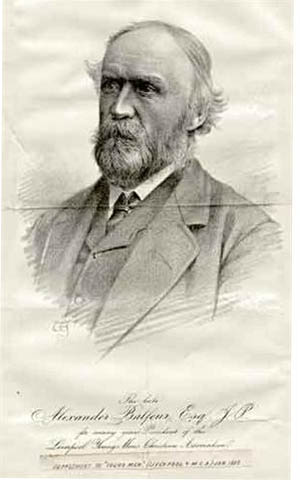
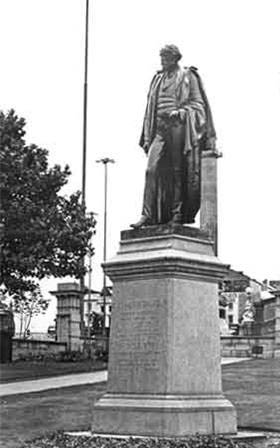
Alexander Balfour (© Liverpool Records Office) The information and pictures were kindly supplied by Liverpool Record Office, at Liverpool Libraries.
Alexander Balfour died at Mount Alwyn on 16 April 1886, and was buried at Rosset Denbighshire.
A monument to Balfour is to be found in the grounds of St Johns Gardens in Liverpool. The Monument is situated in the North East corner of St John's Gardens.
Balfour is shown in contemporary dress, consisting of an Inverness cape over an open frock, his right leg is forward giving the impression that his weight is borne by his left leg. In his raised left hand he is holding papers, to his right is a bollard, a rope and an anchor.
The inscription reads: “Alexander Balfour merchant, ship-owner, born 2nd September 1824, died 16th April 1886, His life was devoted to God in noble and munificent efforts for the benefit of sailors, the education of people, and the promotion of all good works.”
Stephen Williamson was born in Cellardyke East Fife on 28th June 1827 one of seven children born to Archibald Williamson,shipowner, maltster, farmer, and his heiress wife Isabella Lawson, sister of Alexander Lawson linen merchant Kingskettle. Educated at Anstruther Burgh School and Madras College where he met Robert Balfour. He worked in a lawyer’s office before he went to Liverpool in 1848 and met up with the Balfour brothers again.
By the age of twenty four Stephen, who had inherited some shipping property from his father, was co-founder with Alexander Balfour, of Balfour Williamson & Co. a shipping company registered in Liverpool trading to South America, with offices in Valparaiso, Chile, San Francisco in the United States and Liverpool, England. Stephen married Annie Guthrie whose father was Dr. Thomas Guthrie of the Ragged School in Edinburgh, where children were fed, clothed and given training. The Williamsons had eight children; among them Archibald born in 1860 who became 1st Barron Forres.
Although successful in business, Stephen was also interested in politics and in 1880 he became a Liberal MP for St Andrews Burghs (East Neuk of Fife). Never forgetting his roots, he and David Fowler (an old school friend) donated the money to build the Town Hall in Cellardyke.
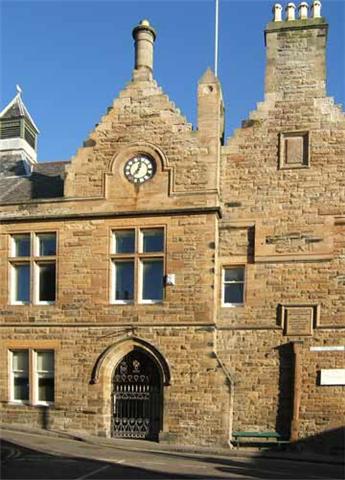
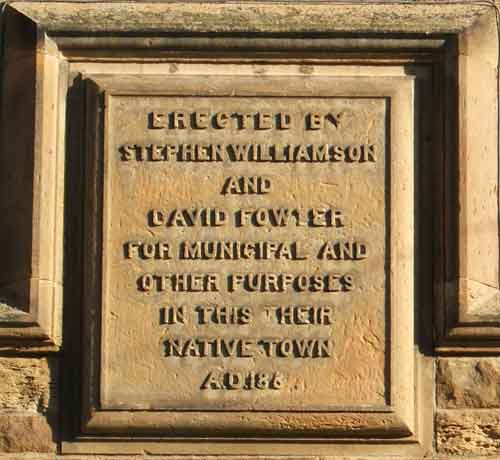
Cellardyke Town Hall
The foundation stone was laid in April 1882 along with a box containing various items of interest, including Town Council minutes, newspapers of the time and a copy of Fisher Life by George Gourlay. Stephen Williamson MP opened the building on September 19th 1883.
He was MP for St Andrews until 1885 and later represented Kilmarnock between 1886 and 1895 and kept his interest in Scottish fishermen and shipping until his death at his home in Copley, Cheshire on the 16th June 1903.
Information from books:-Heirs of Great Adventure by Wallis Hunt, publisher London (for private circulation 1951-1960) and Kilrenny and Cellardyke:800 years of history, Edinburgh; John Donald 1986.
David Duncan born 1830 at Aylth, Angus, fourth son of James Duncan manufacturer and merchant. He was educated at Dundee High School before leaving for South America with his elder brother James (later James Duncan of Jordanstone) where they became very successful traders.
www.clan-duncan.co.uk/duncan-jordanstone.html
In 1851 at 20 years of age he became a partner with Balfour & Williamson having a family connection through Stephen Williamson’s uncle Alexander Lawson linen manufacturer Kingskettle who put up some money. He and Stephen Willianson were responsible for the offices in Valparaiso where they were quite adventuresome in their business deals while Alexander Balfour remained in Liverpool taking care of the shipping from England where he was renowned for his thourough, no risk approach to his work.
In 1856 he married Catherine Williamson of Anstruther and their first son was born in Valparaiso two years later.The partnership between the three became rather dificult so the Duncans returned to England to Gayton Hall in Cheshire where he continued his work as Duncan,Fox & CO.He also entered Parliament as Liberal M.P. for Barrow in Furness in 1885 but died the following year.
The Balfour Williamson Shipping Co. had many ships but the most important one was the Santiago built to replace the Gardner, their first ship, which had been sold. Santiago was the only ship added the their fleet in the 1850's Built in Methil Fife, by Henry Balfour it sailed mainly from Liverpool to Chile but also to Australia. The Santiago was registered in Liverpool, a 455 ton barque whose first Captain was R. Fowler followed in 1862 by Captain T. Davidson and then in 1865 by Captain D. Wilson. Information from:- National Museum Liverpool
The ship was sold to Germany in 1888 and two years later was bought by the Norwegians. Around 1900 it was purchased by the Adelaide Tug Company and dismasted on the East Coast of Australia. The following August it carried a cargo of coal from Newcastle in New South Wales to Adelaide. The new owners converted it to a hulk, a coal store for the newer coal powered steam ships. In 1918 it was sold to The Adelaide Steam Co. and occaionally was used for salvage work on stranded vessels and also did lightering. It remained in service until 1945 when it was abandoned.
The Santiago now lies in the ships graveyard in North Arm near Garden Island, Port Adelaide. It is the oldest ship there and its hull is mostly intact, the water is shallow and it can be seen at all time. Because it was dismasted and used as a coal hulk there is not very much left of the original fittings, although some things do remain. Sadly during a storm in 2001 her back was broken, but some preservation treatment has been carried out.
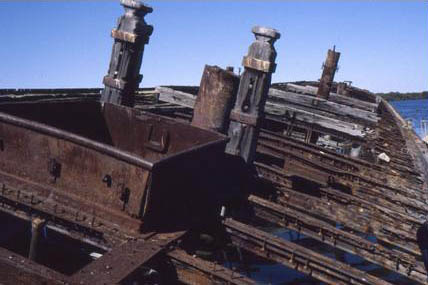
Deck of the Santiago
(© Dept.for Environment and Heritage, South Australia)
Under the South Australian Historic Shipwrecks Act 1981 the Santiago has been declared an historic shipwreck.This is a very important piece of shipping history as information can be gained about the construction of an iron hulled ship, also it is reminiscent of the days of sail.
This is quite a fitting tribute to an old lady of the sea who was built in Methil Fife Scotland.
Henry Balfour of Leven is still a major industry in the town of Leven, and although there have been some changes including the name, now Pfaudler Balfour, in 2010 it will celebrate its bi-centenery, another great achievement from humble beginnings in 1810.
Acknowledgements:-
Department for Environment and Heritage, South Australia
National Library of Scotland
Methil, Leven and Cupar Libraries
Dawn Littler, Curator of Archives Liverpool Museum
Roger Hull, Researcher Liverpool Records Office
David Nutley, Principal Maritime Heritage Officer, Adelaide Australia
John Duncan - Clan Duncan website
Jane Hayhow, Anstruther